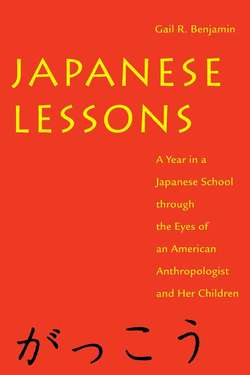Читать книгу Japanese Lessons - Gail R. Benjamin - Страница 16
На сайте Литреса книга снята с продажи.
REPORT CARDS, JUKU, AND EXAMINATIONS
ОглавлениеThere are some other contexts in which teachers make very overt judgments of student work. Homework is often corrected by the teacher and is used as a monitor of student progress. Report cards also reflect evaluation by teachers. Because there is a standard curriculum and a timetable for getting through it, the report card for each marking period, three a year, lists specific areas of competence, such as “addition and subtraction of numbers through 100” in the third term of first grade. Students are graded as average, high, or low. There are schoolwide criteria for assigning the grades: 15 percent of the students get “high,” 75 percent “average,” 10 percent “low” at Okubo Higashi. These grades have few or no consequences. Passing a grade does not depend on grades—everyone passes, as a matter of national policy. Being a student of a certain grade is a process of life, not an accomplishment. After all, no one fails to pass from being nine years old to being ten years old, and similarly it is impossible to fail to become a fourth-grade student after a year as a third-grade student.
There are two other arenas, very different from the institutional elementary schools, in which children and parents get “authoritative” feedback on academic performance. One is juku and private testing services, and the other is the high school entrance examinations. Juku are private, commercial tutoring schools. They range from in-home tutoring of a few students by a housewife, through neighborhood operations that enroll enough children to support a family, though probably modestly, to nationwide chains with hundreds of branch offices. They divide children by achievement levels and provide remedial help for those who are falling behind, additional practice for those who are keeping up, and accelerated or enriched programs for the academically advanced. They have smaller classes and a more overtly competitive style of teaching than are found in schools. They are cram schools of different levels, geared toward improving students’ performances on the high school entrance examinations. After-school classes that children take in sports or art are also called juku.
The willingness of most parents to pay noticeable amounts of money for tutoring in commercial establishments, which make extensive use of repeated, indeed tedious, testing and ranking, indicates that parents think this activity is important. The crucial importance of placement in high schools as a determiner of the options available to students for the rest of their lives is well known to all Japanese parents and adults. Grades and teacher recommendations have nothing to do with the process, only the results of the high school entrance examinations. High schools are ranked by the test achievement levels of their entering students, which in turn are directly linked to the university entrance success or the employment success of their graduates. In one sense, looking at the situation from outside, it seems that gaining admission to a particular high school only predicts, more or less, a student’s success in gaining admission to a particular college later on, or in obtaining employment with certain employers. Japanese participants in the process, however, act as though getting over the high school entrance barrier definitely determines their ability to get over the next college or employment entrance barrier.
The issue of high school admission is complicated, and it varies somewhat from one part of Japan to another, but it can be briefly described as follows: high school is not part of the compulsory school requirement in Japan; the legal school-leaving age is after finishing ninth grade. However, about 95 percent of Japanese children do enter high school, and nearly all of them graduate. About 30 percent of high school students attend private schools; the rest are in public schools. Both public and private schools charge fees, and both require students to take entrance examinations. There are several vocational curricula, as well as general academic and college preparatory academic programs. Within a school jurisdiction, which may be as large as a prefecture, there are no residence requirements for attending a particular high school, so schools choose entrants on the basis of their examination scores. The result of this process is that all the students in a high school are academically very similar—in strong contrast to students in the untracked compulsory levels of school. Because the student bodies of individual high schools are academically very similar when they enter, it is not too surprising that they are academically very similar when they graduate. The ranking of public and private high schools in terms of the examination scores of their new students, and in terms of the college and employment placements of their graduates, is widely known by the general population and by teachers and parents.
There is a contradiction between the importance of authoritative evaluations of academic performance in juku and in entrance examinations and their absence in the institutional setting of elementary schools. The situations in which “authorities,” either the juku and testing services or the high schools in giving entrance examinations, evaluate student performance are resolutely separated from the elementary school context itself; I think they are viewed as antithetical to the social values and relationships that schools are entrusted with teaching. Schools and teachers feel, and say, that juku are inappropriate for children, unhealthy and unnecessary. The examinations for high school entrance (and later university entrance) are felt to be like an external foe, against which students and teachers alike struggle for success. These evaluations and rankings are not something imposed by teachers on students. Teachers teach; they do not evaluate, and they do not hold their students’ fates in their hands directly.
